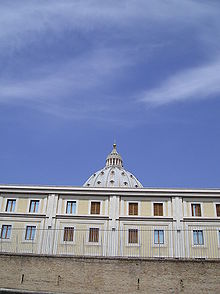- Domus Sanctae Marthae
-
Coordinates: 41°54′2″N 12°27′12″E / 41.90056°N 12.45333°E
The Domus Sanctæ Marthæ (Latin for Saint Martha's House) is a building completed in 1996 adjacent to Saint Peter's Basilica in the Vatican City built during the reign of Pope John Paul II. It functions as a guest house for those having business with the Holy See, but it is best known as the hotel residence of the College of Cardinals taking part in the papal conclaves to elect new Popes. Its amenities include furnished bedrooms, lavatories and studies for each prelate. Dining facilities and personal services are also offered.
Contents
Facilities
The five-story building consists of 106 suites, 22 single rooms and one apartment. It is run by the Daughters of Charity of St Vincent de Paul.[1]
The hotel cost US$20 million with $13 million of it pledged initially by Pittsburgh, Pennsylvania casino owner John E. Connelly who received a contract to sell copies of Vatican art in the United States. Connelly would back out of the initial commitments after the casinos ran into financial trouble. His art contract was also rescinded after he could not find a market beyond Pittsburgh.[2]
Connelly proposed Louis D. Astorino, a Pittsburgh based architect, to design the building. His design was ultimately rejected but he remained as supervisory architect and designed the adjoining Chapel of the Holy Spirit.[3] Astorino is the first American architect to design a structure in the Vatican.
History
The building replaced the St. Martha Hospice built in 1891 during a cholera epidemic for Pope Leo XIII that was dedicated to the sick in neighborhoods around the Vatican. During World War II the earlier structure was used by refugees, Jews, and ambassadors from countries that had broken diplomatic relations with Italy.
Prior to the Apostolic Constitution Universi Dominici Gregis — promulgated on February 22, 1996 that changed the rules governing papal conclaves — participants were forced to sleep in the Apostolic Palace on rented cots, usually borrowed from seminaries in Rome. After participants were sealed under lock and key in the Apostolic Palace, the electors would live in makeshift rooms built throughout the palace, including within hallways and offices. The rooms, assigned to each Cardinal by lot, would often be constructed by nothing more than a sheet hanging on a rope. Sturdier walls would not be available because of the cost and because they would damage the Palace walls. In addition to the rented cots, each room would be equipped with a Crucifix and kneeler, a desk and one or two chairs. The Cardinals would have to share common bathrooms, often with ten Cardinals assigned to each. The situation would especially be difficult as a significant portion of Cardinals tend to be elderly.
Pope John Paul II, after himself participating in two Conclaves, decided to make the process more comfortable and less strenuous on the elderly Cardinals and commissioned the construction of Domus Sanctæ Marthæ.
2005 Conclave
As with previous practice, the Cardinals would be assigned their rooms by lot. Cardinals' rankings would have no effect on which room they would receive. Cardinal Ratzinger, in the 2005 Conclave, was assigned to a simple room even though he was the Cardinal Dean and one of the longest-serving in the College; after he had been elected Pope, he was invited to transfer to the fancier Patriarchal Suite. The new pope, known for his humility and only having become Pope a few hours earlier, is said to have been astonished at the invitation to a superior room.
During a Conclave, all radios, television sets and telephones would be disconnected, as per regulations which call for the Cardinals to be secluded from the outside world to prevent any undue influence on their voting.
According to Professor Mary Ann Glendon in an interview with EWTN, the Domus Sanctae Marthae does not resemble a five-star hotel as the Western media often represents it to be; rather, it was designed according to standards of monastic simplicity.
References
- ^ Domus Sanctae Marthae & The New Urns Used in the Election of the Pope - ewtn.com - Retrieved February 10, 2009
- ^ Connelly's plan to market replicas never took hold beyond Pittsburgh - Pittsburgh Post-Gazette - January 9, 2001
- ^ Pittsburgh architects leave mark on Vatican City - Pittsburgh Tribune-Review - April 22, 2003
Categories:- Palaces in Vatican City
- College of Cardinals
- Buildings and structures completed in 1996
Wikimedia Foundation. 2010.

